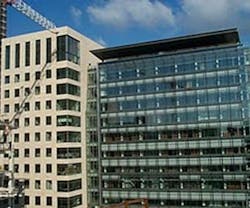Remember the bad Chinese gypsum board recalled last year? Some will never forget the drywall, which emitted noxious sulfur fumes and had to be torn out of schools and condominiums around the country.
According to news report last week from USGlass, Chinese bauxite and aluminum may be the next scourge of American commercial buildings. While U.S. curtainwall manufacturers extrude their own material based on carefully controlled alloys using proper billets, some Asian manufacturers stand accused of less rigorous practices, said Oliver Stepe, senior vice president with YKK AP in Austell, GA, a maker of architectural aluminum storefronts and curtainwall. The result: Facades that may not be reliable over the long term.
Installing good-quality metals that meet project specifications is only one determinant of a curtainwall’s life-cycle durability, says John F. Straube, Ph.D., P.Eng., a building science engineer. Much more important, he contends, is the use of continuous insulation, or CI – one of the latest buzzwords of energy-efficient building envelopes.
“A desire to increase energy efficiency is driving the use of continuous insulation, but durability was the original motivation,” says Straube. “It is now in the codes for energy reasons, but it also ensures that critical, moisture-sensitive components are maintained at closer to room temperatures.”
Indeed, codes are motivating the use of CI. Both energy standards ASHRAE 90.1 and ASHRAE 189.1 call for continuous, exterior thermal insulation in at least six of eight U.S. climate zones. By keeping curtainwall assemblies protected by these uninterrupted blankets outboard of the steel structure, a more stable regime of temperatures within protects steel and aluminum members from condensation and temperature swings. “We call that a museum,” Straube quips, “because it’s how you keep something preserved for a long, long time. It’s a tremendous increase in durability.”
The question from design architects and engineers is, how does CI apply to a curtainwall that is mostly glass? In the light of recent design trends toward more glazed area, it’s even more challenging. “People want more visual connection to the outdoors, but these thermal requirements kill transparency,” says Erin McConahey, P.E., an engineer in the Los Angeles office of Arup.
One solution is the use of better insulating glazing for both vision and spandrel glass. Another is double-wall construction, which is more suited to the climate in Northern Europe than in North America, explaining its infrequent use here. Still, more buildings are being detailed with double curtainwalls, such as the NBBJ-designed Seattle Justice Center. The double-skin envelope is vented to draw heat out of the enclosure, reducing cooling loads.
Whether a traditional curtain wall or a more progressive double-skin, vision glass is typically specified with low-emissivity coatings and, increasingly, with argon or krypton gas fills and suspended films between the glass panels, that better manage solar heat gain. Spandrel glass often has opacifiers, such as a film, paint or ceramic frit, applied on an unexposed surface, or it may be made opaque through shadow-box construction – an enclosed space behind clear spandrel glass. In the former case, the glass performs the primary insulating function; in the latter, spandrels act more like exposed metal sections of curtainwall.
Metal panels can take various forms, according to the curtainwalls section of the Whole Building Design Guide (WBDG, www.wbdg.org), authored by Nik Vigener, P.E. and Mark A. Brown, two designers with Simpson Gumpertz & Heger, and building enclosure experts Richard Keleher, AIA, and The Facade Group’s Rob Kistler. Materials options include aluminum plate, stainless steel or another noncorrosive metals, or composite panels such as thin aluminum/plastic sandwich materials or metal sheets bonded to rigid insulation.
Assuming the curtainwall’s metal panels are from reputable stock, continuous insulation is the critical determinant of long-term durability, according to building scientists like Straube – but so is the air barrier, say the WBDG authors.
“Due to the lack of interior air adjacent to opaque curtainwall areas, wide swings in temperature and humidity” are possible, they contend, requiring “careful detailing of insulation and air/vapor barriers to minimize condensation.” Perimeter flashings, thermally broken structural connections, and proper placement of insulation are a few of the key design issues.
Yet it’s easy to undermine curtainwall performance, warn facade consultants. For example, condensate gutters and other drainage weeps must always be outboard of the backpan so they do not violate the air barrier plane. Even a good thing like insulation can cause problems, according to the WBDG: “Insulating mullions in a spandrel area may lead to excessive condensation in cold climates,” due to humid air from the interior contacting the mullions.
C.C. Sullivan ([email protected]) is a marketing communications consultant and writer specializing in architecture, design, and construction technology.
